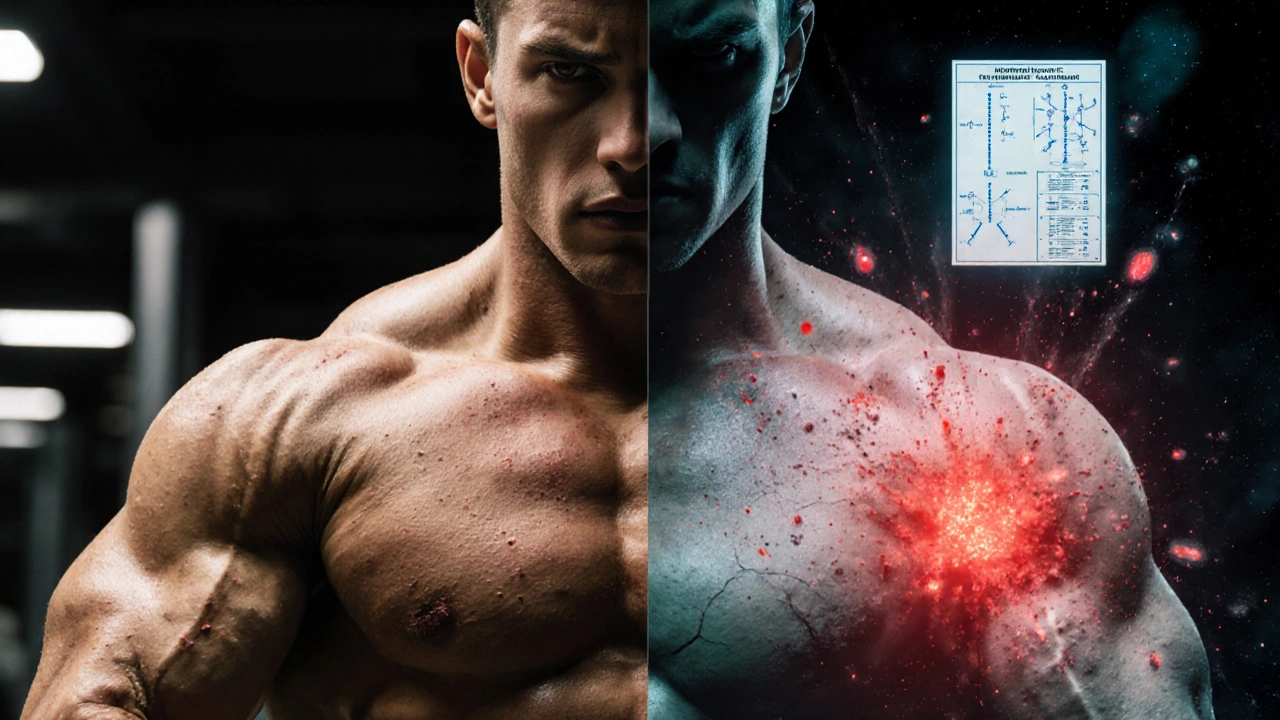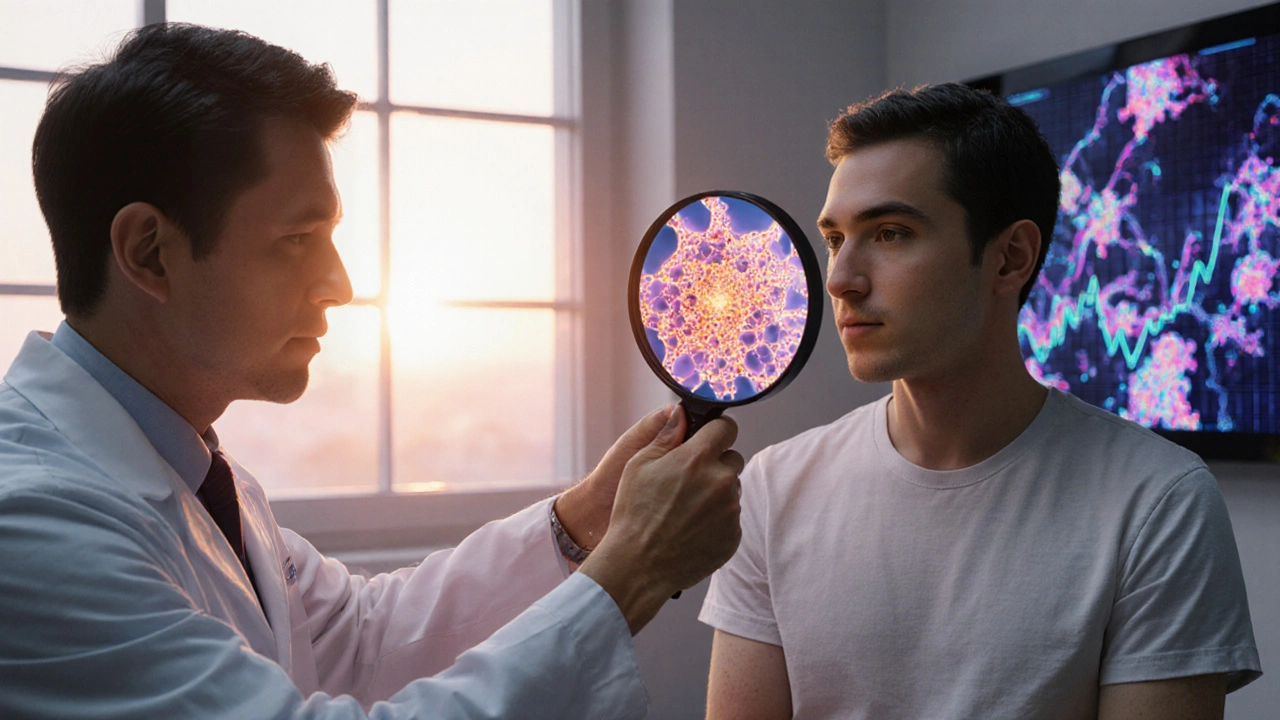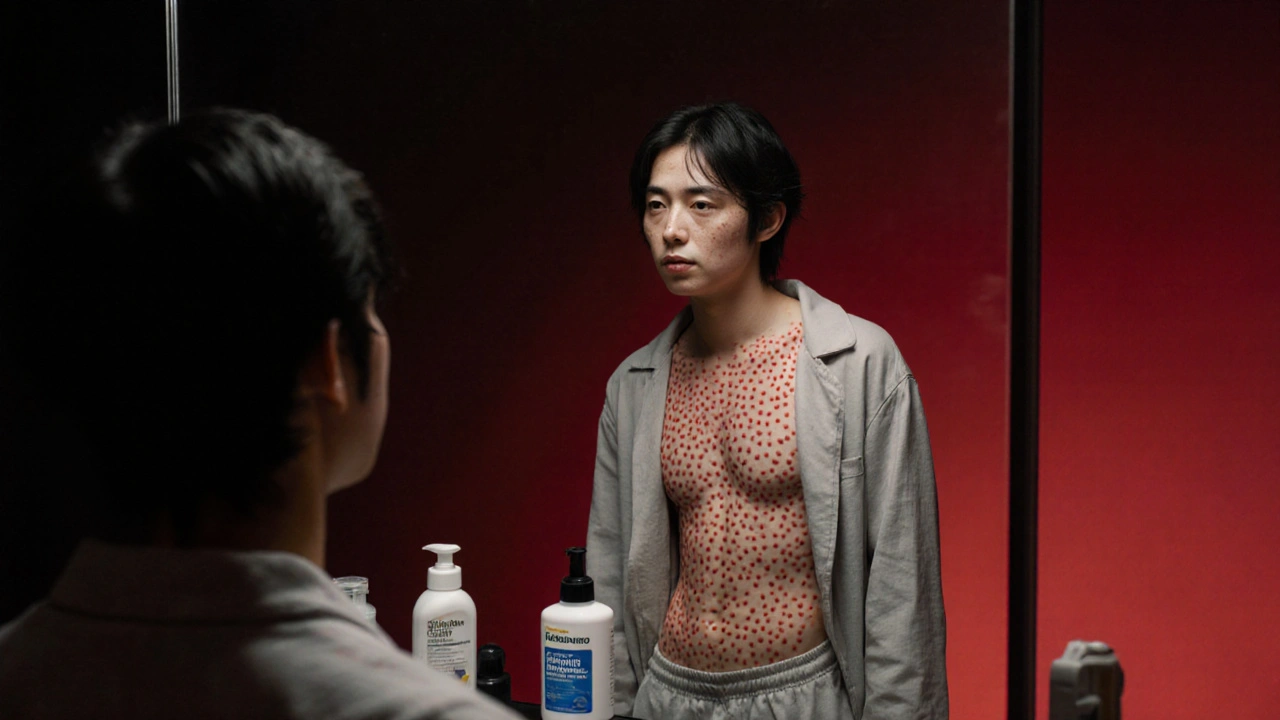Steroid Acne Risk & Treatment Calculator
Steroid Acne Risk Assessment
This tool helps estimate your risk of developing steroid acne and provides personalized treatment recommendations based on your steroid use.
When you start taking steroids-whether for asthma, an autoimmune disease, or bodybuilding-you might not expect your skin to turn against you. But for many, weeks into treatment, a wave of angry red bumps appears on the chest, back, or face. These aren’t just regular pimples. They’re steroid-induced acne, a direct side effect of corticosteroids or anabolic steroids that can feel confusing, frustrating, and even alarming.
What Makes Steroid Acne Different?
Steroid acne doesn’t look like teenage acne. It’s not scattered with blackheads and oily T-zones. Instead, it shows up as dense clusters of small, uniform red bumps-often on the chest and upper back, not just the face. These lesions are follicular, meaning they center around hair follicles, and they tend to appear suddenly after 4 to 6 weeks of steroid use. In some cases, they’re not acne at all, but Malassezia folliculitis, a yeast overgrowth triggered by steroids that causes itchy, pimple-like bumps without comedones. Unlike regular acne, which stems from hormones, oil, and bacteria, steroid acne is driven by how steroids interact with your skin’s immune response. Research from 1973 and updated studies in 2023 show that corticosteroids increase expression of Toll-like receptor 2 (TLR2) on skin cells. This receptor normally helps fight off bacteria, but when overstimulated by steroids, it turns harmless Propionibacterium acnes into an inflammatory trigger. The result? Pimples that don’t respond to your usual acne routine.Who Gets It-and Why?
Anyone on long-term or high-dose steroids is at risk. That includes people taking prednisone at 20 mg/day or more for conditions like Crohn’s disease, lupus, or after an organ transplant. But it’s not just medical users. Anabolic steroid users in bodybuilding communities report severe outbreaks, often called “bodybuilding acne,” with lesions that can become deep, painful, and even ulcerated. Adolescents and young adults are more susceptible, likely because their skin is more reactive to hormonal shifts. But age doesn’t matter if the steroid dose is high enough. About 10-20% of patients on systemic corticosteroids develop noticeable acne. And in bodybuilding circles, the rate is likely higher-some experts estimate up to 50% of users experience skin changes.Topical Treatments That Actually Work
The good news? You don’t have to wait until you stop steroids to see improvement. Topical treatments can clear lesions even while you’re still on the medication. Tretinoin 0.05% is the gold standard. Back in 1973, a study of 12 patients showed that applying tretinoin once or twice daily cleared 85-90% of steroid acne lesions within 8-12 weeks-even while continuing prednisone. Today, dermatologists still recommend it as a first-line option. Start slow: apply a pea-sized amount every other night to avoid irritation, then increase to nightly as your skin adjusts. Benzoyl peroxide 5% is another essential tool. It kills acne-causing bacteria and reduces inflammation. Use it as a wash on the chest and back for 1-2 minutes before rinsing. Don’t overdo it-too much can dry out skin already weakened by steroids. For Malassezia folliculitis, ketoconazole shampoo (2%) or selenium sulfide shampoo (2.5%) works wonders. Apply it to the affected areas, leave it on for 5-10 minutes, then rinse. Do this 2-3 times a week. Many patients report itching and redness fading within 2 weeks.
Oral Options When Topicals Aren’t Enough
If your acne is widespread, painful, or not budging after 6 weeks of topical treatment, oral options come into play. Doxycycline (100 mg twice daily) is often prescribed for 3-4 months. It reduces inflammation and bacterial load. But long-term use risks antibiotic resistance, so it’s not a forever solution. For women, oral contraceptives containing ethinyl estradiol and progestin can help by lowering androgen levels. Spironolactone (25-50 mg daily) is another anti-androgen that’s effective for hormonal acne, including steroid-triggered breakouts. Isotretinoin (Accutane) is powerful-it can clear even severe cases. But here’s the catch: in people using anabolic steroids, isotretinoin can trigger acne fulminans, a rare but dangerous condition with deep, ulcerating lesions and fever. Two documented cases in bodybuilders required hospitalization after starting isotretinoin during a steroid cycle. Dermatologists now warn: never use isotretinoin while actively using anabolic steroids. Wait at least 3-6 months after stopping them before considering it.Lifestyle Adjustments That Make a Difference
Medication alone won’t fix everything. Your daily habits play a huge role.- Avoid harsh scrubs. Steroids thin the skin. Rubbing or exfoliating aggressively can cause microtears and worsen inflammation.
- Use non-comedogenic moisturizers. Steroids dry out your skin barrier. A simple, fragrance-free moisturizer with ceramides helps repair it.
- Wear loose, breathable clothing. Tight synthetics trap sweat and heat, creating a breeding ground for yeast and bacteria. Cotton is your friend.
- Shower right after workouts. Sweat sitting on skin for hours feeds acne-causing microbes. Rinse off within 30 minutes.
- Protect your skin from the sun. Tretinoin, benzoyl peroxide, and steroids all increase photosensitivity. Use a mineral sunscreen (zinc oxide or titanium dioxide) daily.
What to Do If You Can’t Stop the Steroids
Many people-transplant recipients, lupus patients, or those with severe asthma-can’t stop their steroids. That doesn’t mean you’re stuck with bad skin. The key is early, consistent treatment. Start topical tretinoin and benzoyl peroxide as soon as you notice bumps. Don’t wait for it to get worse. Studies show delaying treatment beyond 8 weeks increases scarring risk by nearly 40%. Work with a dermatologist who understands steroid-induced acne. Telemedicine platforms like Curology and Apostrophe have seen a 30% rise in steroid acne cases since 2020. They specialize in personalized regimens, often combining tretinoin, antibiotics, and lifestyle advice without requiring in-person visits.
What Doesn’t Work-and Why
Don’t waste time or money on these:- Over-the-counter acne cleansers with salicylic acid. They’re designed for mild acne, not steroid-triggered inflammation.
- Tea tree oil or natural remedies. While they may help mild acne, they don’t penetrate deeply enough to affect follicular inflammation caused by steroids.
- Stopping steroids cold turkey. This can be dangerous. Always taper under medical supervision.
- Using multiple strong products at once. Layering tretinoin, benzoyl peroxide, and retinol? That’s a recipe for a chemical burn. Stick to one active at a time.
When to See a Dermatologist
See a specialist if:- Lesions are painful, oozing, or spreading rapidly
- You develop fever or feel unwell alongside the breakout
- Topical treatments haven’t improved things after 8 weeks
- You’re on anabolic steroids and considering isotretinoin
The Road Ahead
Research is moving fast. New topical inhibitors targeting the TLR2 pathway are in Phase II trials and show 65% reduction in lesions after 12 weeks. Companies are also exploring microbiome-based treatments-like applying beneficial bacteria to restore balance after steroids disrupt it. For now, the best approach is simple: recognize the signs early, use proven topical treatments, adjust your lifestyle, and work with your doctor. You don’t have to choose between managing your health condition and protecting your skin. With the right plan, you can do both.How long does steroid acne last after stopping steroids?
Most cases clear up within 4 to 8 weeks after stopping steroid use. But if you’re still taking steroids for a medical condition, the acne can persist longer. With proper treatment-like tretinoin or benzoyl peroxide-lesions can improve significantly even while continuing the medication.
Can steroid acne turn into regular acne?
No, steroid acne is a distinct condition triggered by steroid exposure. But once you stop the steroids, your skin may return to its baseline-meaning if you were prone to regular acne before, it could reappear. The two aren’t the same, but they can coexist.
Is isotretinoin safe for steroid acne?
It’s effective for corticosteroid-induced acne, but dangerous for anabolic steroid users. In bodybuilders, isotretinoin can trigger acne fulminans-a severe, ulcerating form of acne that may require hospitalization. Always disclose your steroid use to your dermatologist before starting isotretinoin.
Why does steroid acne appear on the chest and back more than the face?
The chest and back have more sebaceous glands per square inch than the face. Steroids increase oil production and alter skin immunity in these areas, making them prime targets for follicular inflammation. Face involvement happens, but it’s less common and often milder.
Can I use acne spot treatments on steroid acne?
Avoid spot treatments with high concentrations of benzoyl peroxide or salicylic acid-they can irritate steroid-thinned skin. Instead, use gentle, full-area treatments like tretinoin or low-strength benzoyl peroxide washes. Targeted treatments often make it worse.
Does diet affect steroid acne?
There’s no strong evidence that sugar or dairy directly worsens steroid acne, unlike regular acne. But a high-inflammatory diet (processed foods, fried items) can make skin more reactive. Focus on whole foods, hydration, and avoiding excessive dairy or supplements like whey protein, which can trigger breakouts in sensitive individuals.
Are there any natural alternatives to tretinoin?
No proven natural alternatives match tretinoin’s effectiveness for steroid acne. Retinol is weaker and slower. Niacinamide helps with redness but doesn’t unclog follicles. Stick with prescription-strength tretinoin-it’s the only topical proven to reverse the comedone buildup caused by steroids.
Can steroid acne cause scarring?
Yes, especially if left untreated for more than 8 weeks. The inflammation can damage hair follicles and lead to permanent indentations or dark spots. Early treatment with tretinoin and benzoyl peroxide reduces scarring risk by up to 60%.


Brad Seymour
November 8, 2025 AT 11:46Bro, I was on prednisone for Crohn’s and this hit me like a truck. Chest and back were covered in these tiny red bumps - looked like I got sprayed with a paintball gun. Tretinoin saved me. Started slow, like the post said, and within 6 weeks, it was 80% gone. No magic, just science. Don’t panic, just act.
Also, shower after every workout. Sweat + steroids = acne party you didn’t invite to.
Malia Blom
November 10, 2025 AT 06:38Let’s be real - this whole ‘steroid acne’ thing is just Big Pharma’s way of selling you more cream. You think tretinoin is the answer? Nah. You think your skin is broken? It’s not. Your body’s just trying to tell you you’re poisoning yourself with chemicals.
Stop the steroids. Let your liver chill. Eat real food. Sleep. Breathe. No lotion in the world fixes a life lived in chemical dependency. This isn’t dermatology - it’s existential.
Erika Puhan
November 10, 2025 AT 20:08While the clinical data on TLR2 upregulation is compelling, the efficacy of topical tretinoin in steroid-induced folliculitis remains statistically marginal when controlled for confounding variables like sebum composition and microbiome dysbiosis. The 85-90% clearance rate cited is likely inflated by selection bias in the 1973 cohort - no mention of dropout rates or placebo controls.
Also, ketoconazole shampoo? That’s a Band-Aid on a hemorrhage. The real issue is systemic immunosuppression. You’re treating symptoms, not root cause. And don’t even get me started on ‘non-comedogenic’ marketing - it’s a regulatory loophole masquerading as science.
Edward Weaver
November 12, 2025 AT 16:17Look, I’ve seen this in the gym. Guys on cycle thinking they can just slap on some Neutrogena and call it a day. Newsflash: if you’re on anabolics, you’re already playing with fire. Isotretinoin? Don’t be an idiot. I’ve seen two guys in my gym get hospitalized after trying it. You don’t mix steroids with Accutane - that’s not medicine, that’s Russian roulette.
And yeah, cotton shirts. Duh. We’re not in kindergarten. But if you’re dumb enough to get steroid acne, maybe you shouldn’t be lifting heavy anyway.
Lexi Brinkley
November 14, 2025 AT 14:15OMG YES THIS IS SO REAL 😭 I was on prednisone for my lupus and my back looked like a crime scene 🤢 Tretinoin was a GAME CHANGER 🙌 I used it every other night and my skin literally healed. Also, zinc oxide sunscreen? NON-NEGOTIABLE. I used the CeraVe one and it didn’t sting. LOVE YOU POST 🫶
Kelsey Veg
November 15, 2025 AT 18:33so like… i was on steroids for like 6 months and my skin went full clown mode. i tried everything. benzoyl peroxide was too harsh, tea tree oil did nothing, and i thought i was gonna be scarred forever. then i tried the ketoconazole shampoo thing and… it just worked? like, i didnt even believe it. i left it on for 10 mins while i brushed my teeth and boom - less itchy. i dont know why it works but it does. thanks for the tip lol
Alex Harrison
November 15, 2025 AT 19:59I’ve been on low-dose prednisone for 3 years now for my RA and this post is spot on. Started with tretinoin after 3 months of bumps - took a while to build up tolerance, but now I’m on nightly. The key is patience. I used to scrub my back like I was trying to remove graffiti. Big mistake. Skin got thinner, red, cracked. Now I just moisturize with ceramides and shower right after I sweat. No more angry bumps. Just… skin. It’s not perfect, but it’s livable.
And yeah, no isotretinoin while on steroids. I’ve seen too many people try it and regret it. Don’t be that guy.
Jay Wallace
November 17, 2025 AT 14:33Let me just say - the fact that you’re even considering natural alternatives to tretinoin… is alarming. Tretinoin is a retinoid - a derivative of vitamin A - clinically proven since the 1970s. Tea tree oil? Aromatherapy nonsense. Niacinamide? A skin-soothing placebo with zero comedolytic action. This isn’t a yoga retreat - it’s dermatology. If you’re going to take systemic immunosuppressants, you owe it to yourself to use the tools that have been peer-reviewed, not Instagram-recommended.
Also, ‘non-comedogenic’ is meaningless without standardized testing. But tretinoin? It’s gold standard. Period.
Alyssa Fisher
November 19, 2025 AT 12:00It’s fascinating how our skin becomes a mirror for internal imbalance. Steroids don’t just cause acne - they reveal how fragile our biological systems are when artificially manipulated. The fact that TLR2 receptors, evolved to defend us, become weapons against our own follicles… that’s biology’s quiet rebellion.
And yet, we reach for creams instead of asking why we needed steroids in the first place. There’s a deeper question here: are we healing, or just managing symptoms? I’m not saying stop treatment - but maybe, just maybe, we should also be asking how to restore balance, not just suppress outbreaks.
Still - tretinoin works. I’ve seen it. And that’s not magic. That’s science honoring the body’s intelligence.
Alyssa Salazar
November 21, 2025 AT 00:51As someone who’s worked in dermatology research for 8 years, I can confirm: Malassezia folliculitis is massively underdiagnosed in steroid users. Most docs just call it ‘acne’ and give them benzoyl peroxide - which does nothing for yeast. Ketoconazole shampoo? Yes. But you need to apply it correctly - leave it on 10 minutes, don’t just rinse. Also, probiotic cleansers are emerging as adjunct therapy - early data shows reduced recurrence rates by 35%.
And isotretinoin in anabolic users? Absolute nightmare fuel. We’ve got case reports where patients developed septic shock from acne fulminans. Don’t be the statistic. Wait 6 months. Period.
Beth Banham
November 22, 2025 AT 20:02I’ve been on steroids for 10 years. My skin’s never been perfect, but I learned to live with it. I don’t stress about it anymore. I use tretinoin twice a week, wear cotton, and shower after I sweat. That’s it. I don’t need to fix everything. I’m alive. My condition’s stable. My skin’s okay. Sometimes, that’s enough.